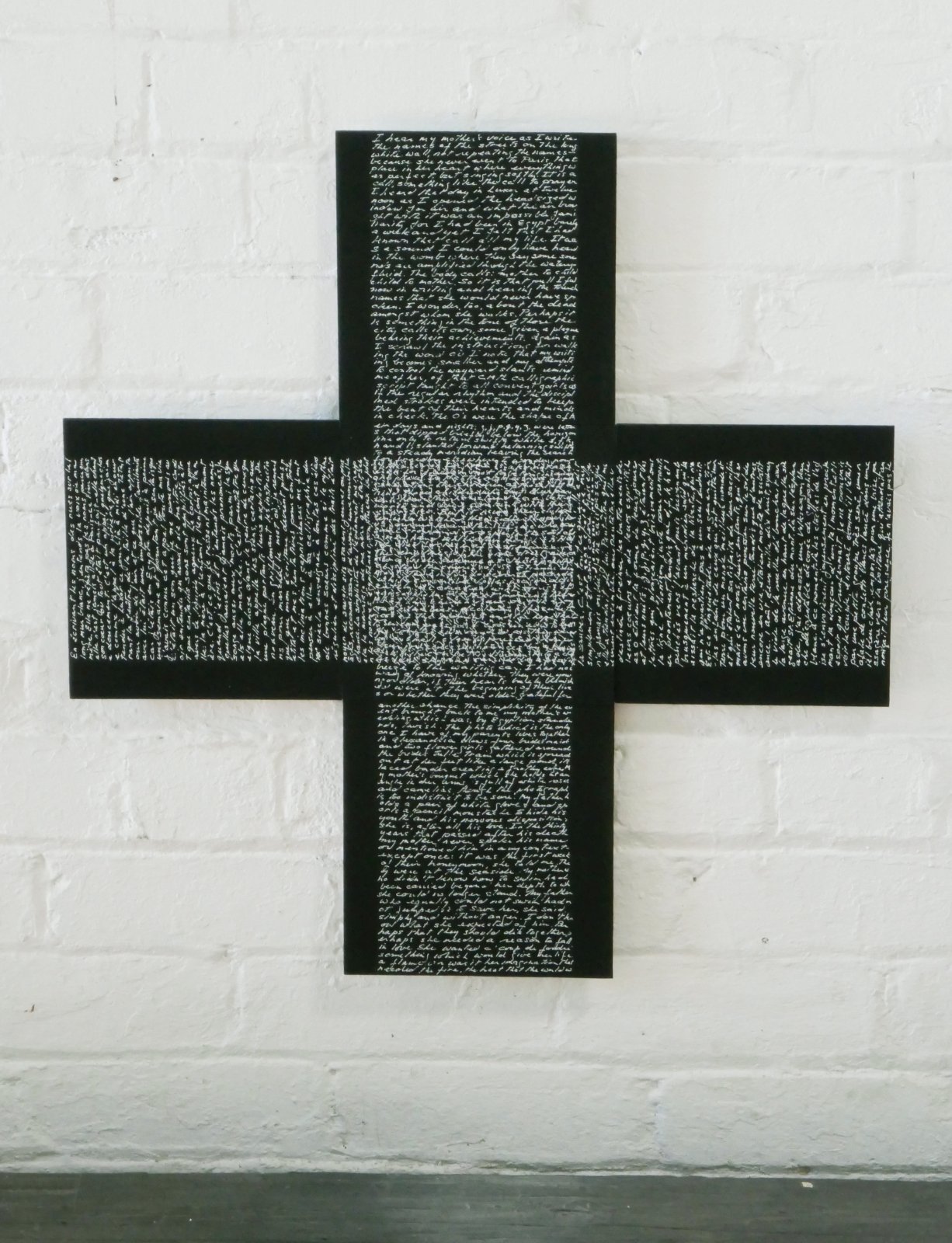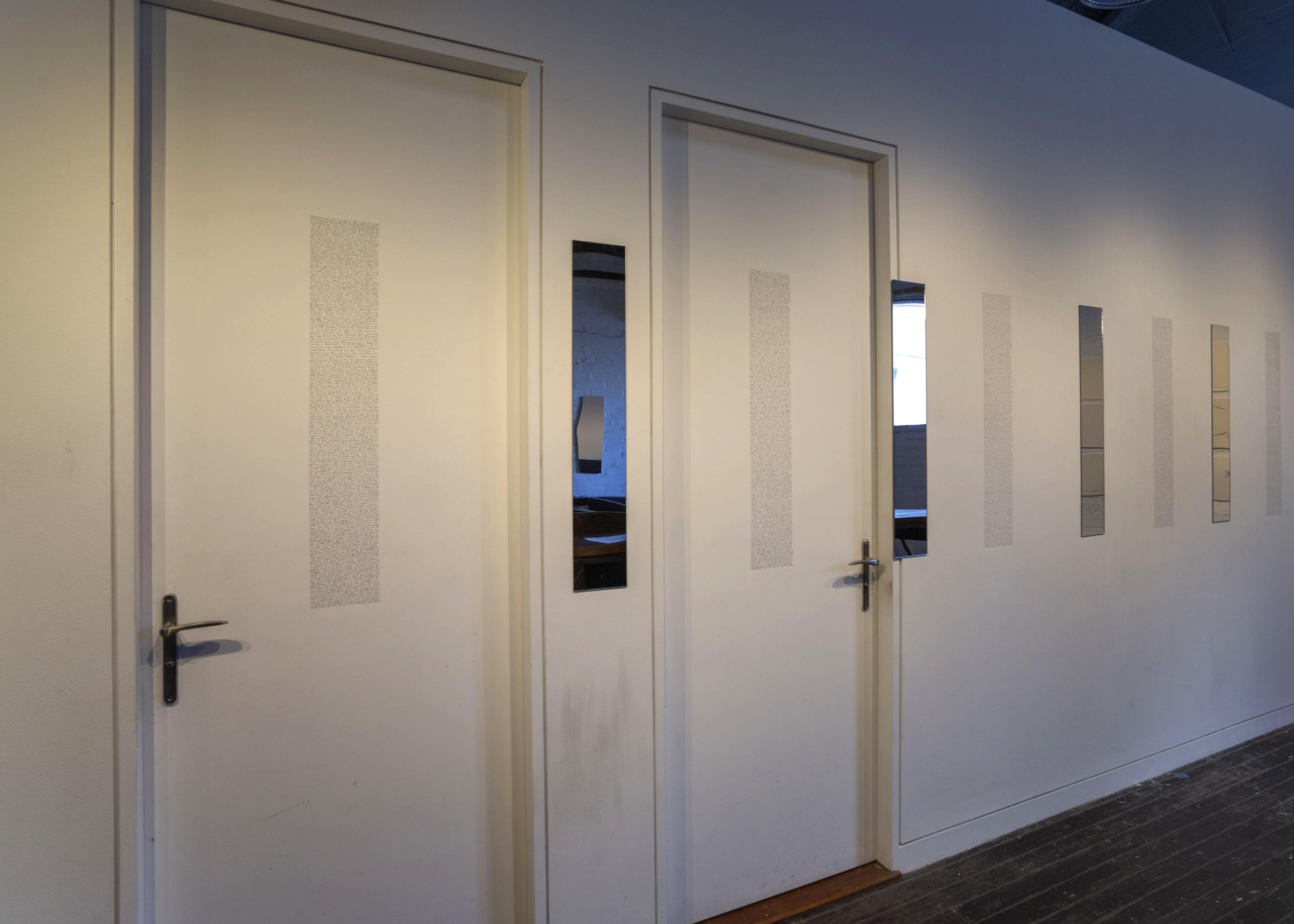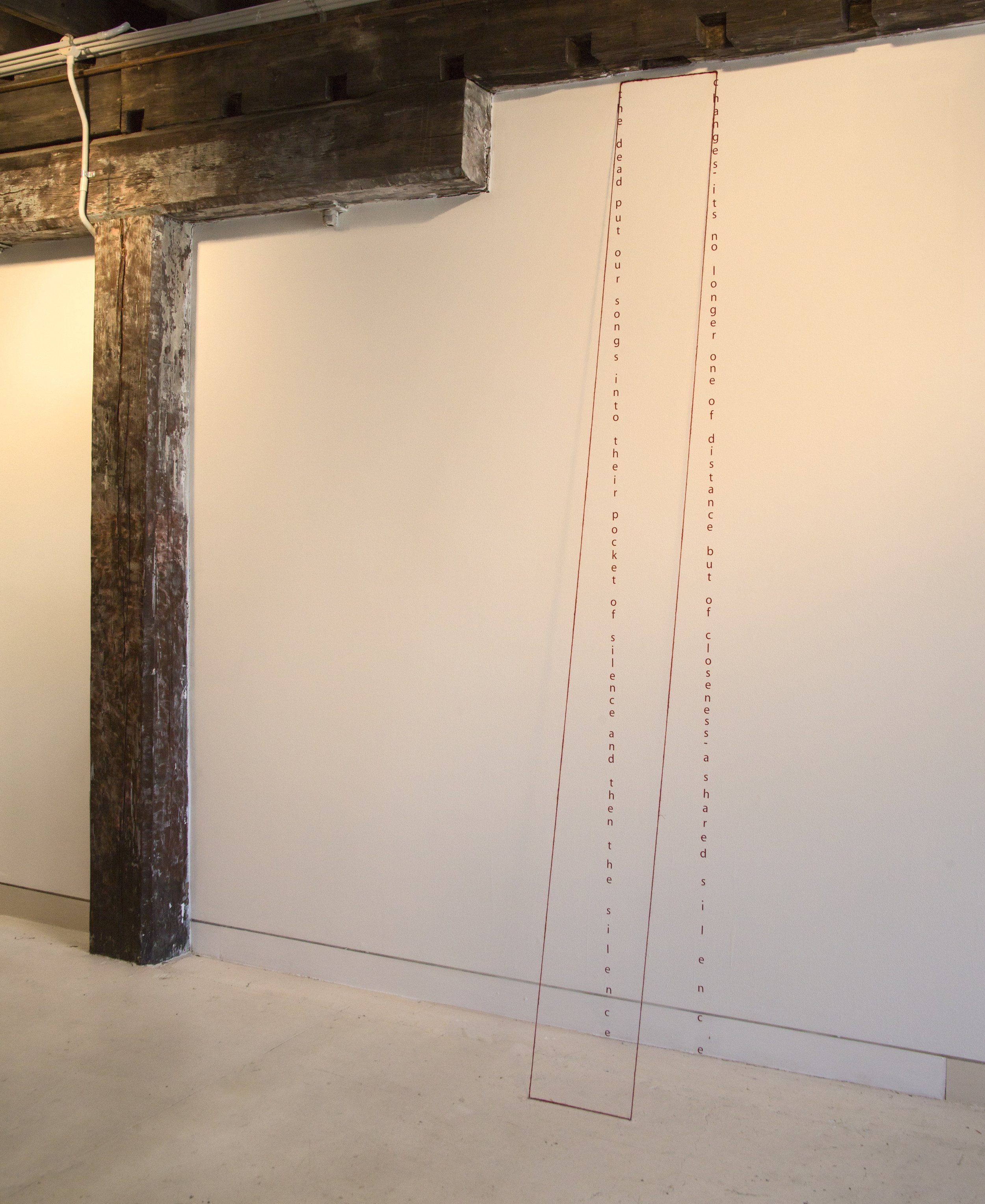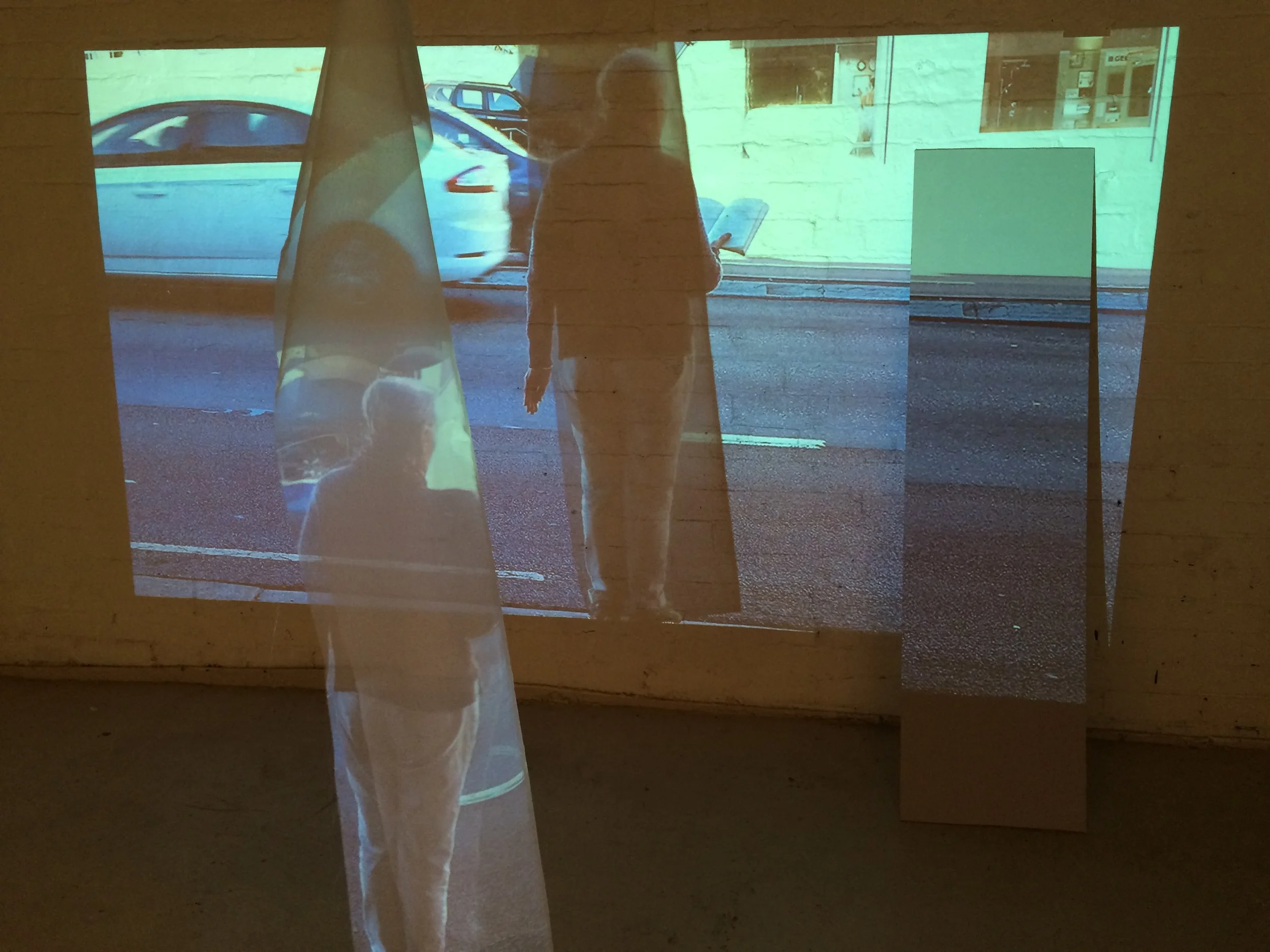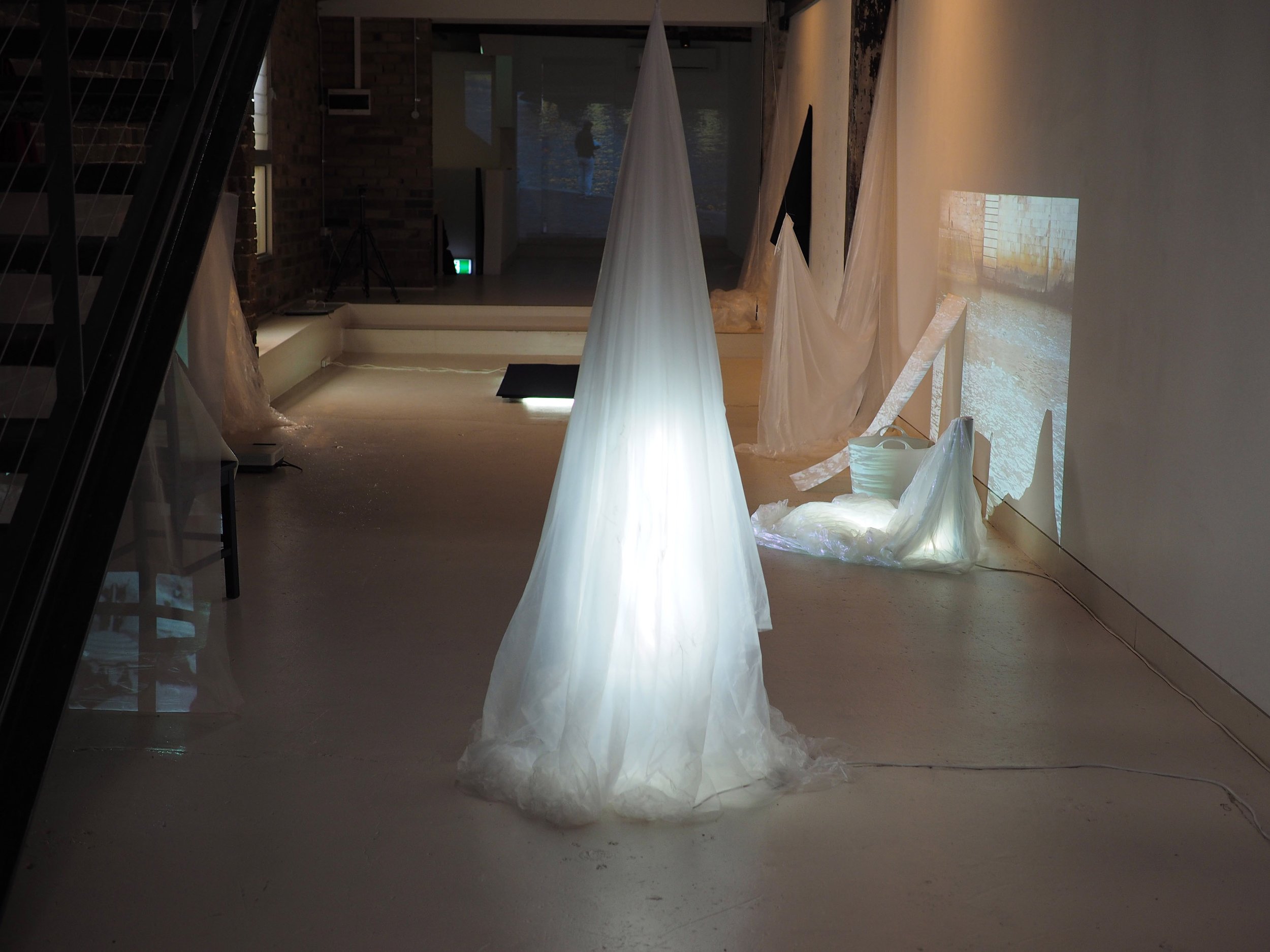The shape of HOSPITALITY
Hospitality is, at the moment, one of the most contested of concepts, its meaning contextual, conditional, contingent, constantly shifting, shrouded in uncertainty and in many instances, fear. The word ‘hospitality’ derived from the Latin hospes/hospis, is an ancient concept. Not only does it mean ‘welcome’ but it refers to an entire range of interactions that de!ne the relationship between the stranger/guest and host- a giving of shelter, of food, a reciprocal sharing of communication and warmth. 428 The work presented on the "oor at the entrance of Factory 49 does not exist and unless the roller door of the space is raised. When the door is closed the word ‘HOSPITALITY’ is cut horizontally. On either side shapes appear as hieroglyphics devoid of meaning. Only when the door is raised can the act of reading take place. The placement of the work across the entrance of the art space, proposes the space of art as a potential space of hospitality, of inclusion. The shape of hospitality, in this instance, is physically the shape of Factory 49 inhabited by those present. It includes the act of reading and of crossing an open boundary into a set of conversations and possibilities, into the hospitality of what is being shown and shared. As the show !nishes the word ‘Hospitality’ is unzipped into the space it’s image opening parallel with its meaning.
First viewing: the door to F49 is closed and a reading is not possible
Second viewing: a reading becomes possible as the door is raised
Third view: unzipping the word
M other Tongue
December 2018
Memory fragment from ‘walking a word’
English text:
I hear my mother’s voice as I write the names of the streets on the long white wall, not repeating the names, because she never went to Paris that place in her heart where everything was perfect, but singing softly. It is a call, something like the call to prayer I heard that day in Luxor at twelve noon as I opened the head-sized window for air and what the air brought with it was an impossible familiarity for I had been in Egypt barely a week and yet I felt that I had known that call all my life. It was a sound I could only have heard in the womb where they say some sounds are ampli!ed through the watery "uid. The body calls mother to child, child to mother. So it is that pull I feel now in writing and hearing the French names that she would never have spoken. I wonder too about the dead among whom she walks. Perhaps it is something in the tone of those the city calls its own, some given a plaque bearing their achievements. Again, as I scrawl the instructions for walking the word Où I note that my writing becomes smaller and my attempts to control the wayward slants remind me of her, of that C19th. calligraphic script taught to all convent girls as if the regular and disciplined rhythm of the strokes was intended to keep the beat of their hearts and minds in check. The O’s were the shape of their days and nights; g,j,p,q,y,z were letters that dipped brie"y below the horizon line only to return swiftly. while d,f,k,h and l, slanted forward returning swiftly to a steady meridian leaving the search for freedom elsewhere. I wonder now, if this search for home is also not a search for freedom, the freedom not to belong in any one place. Is that the restlessness of my generation–the children of those who left their homeland for a better world and were content with their sacri!ce. But it is we their children who watched them su#er the perilous journey to another life, we who saw some grow and prosper in the soil of a new land while others, though living, died for lack of sustenance.
French Text:
J’entends la voix de ma mère en écrivant les noms des rues sur le long mur blanc. Elle ne répète pas les noms, parce qu’elle n’est jamais allée à Paris – ce lieu dans son coeur où tout était parfait – elle chante doucement. C’est un appel, quelque chose comme l’appel à la prière que j’ai entendu à Luxor ce jour-là à midi en ouvrant la fenêtre de la taille d’une tête pour avoir de l’air et ce que l’air apporta avec lui était une impossible familiarité car j’étais en Egypte depuis à peine une semaine et pourtant je sentais que j’avais connu cet appel toute ma vie. C’était un son que je ne pouvais avoir entendu qu’avant de naître. On dit que certains sons sont ampli!és à travers le liquide aqueux.Le corps appelle: la mère à l’enfant, l’enfant à la mère.C’est ce que je ressens maintenant quand j’écris et j’entends les noms qu’elle n’auraient jamais prononcés. Je songe aussi aux morts parmi lesquels elle marche. C’est peut-être quelque chose dans le genre de ceux que la ville appelle les siens, certains avec une plaque portant leurs exploits.De nouveau, en gri#onnant les instructions pour marcher le mot Où, je remarque que mon écriture devient plus petite et mes tentatives pour contrôler les inclinaisons capricieuses me font penser à elle, à sa calligraphie du XIX° siècle enseignée à toutes ces élèves de bonnes soeurs comme si le rythme régulier et discipliné des traits était destiné à freiner les battements de leurs coeurs et de leurs esprits. Les O étaient la forme de leurs jours et de leurs nuits; g,j,p,q,y,z étaient des lettres qui plongeaient brièvement sous la ligne d’horizon juste pour remonter promptement, tandis que d,f,k,h et I, penchés vers l’avant puis revenant promptement à un méridien solide qui laissait la recherche de la liberté quelque part ailleurs. Je me demande maintenant si cette recherche du chez soi n’est pas aussi une recherche de la liberté, la liberté qui n’appartient pas à un seul endroit.Est-ce l’inquiétude de ma génération -les enfants de ceux qui ont quitté leur terre pour un monde meilleur et qui étaient satisfaits de leur sacri!ce-.Mais c’est nous, leurs enfants, qui les avons observés subir le voyage périlleux vers une autre vie, nous qui en avons vu certains pousser et prospérer sur le sol de leur nouvelle terre tandis que d’autres, encore en vie, étaient morts faute de subsistance.
Walking a word
August 2018
Walking a Word is fundamentally a work of drawing, a performative act made with the whole body expanded into everyday life. It is my body walking/drawing the word où on the shared ground of the 5th arrondissment in Paris. The word où refers to the question – ‘where is home’. Three walks spread over three separate days in the same location repeatedly ask the same question as if there might be di#erent answers to be found. Each of the walks takes a particular shape– o, `, u, –shapes that together spell the word ‘where’ in French. The city itself o#ers (and obstructs) more than one possibility for walking these shapes.In this work the word où is used as a hinge between two modes of being. One a pragmatic reality, the common act of walking in a public space in which we share the ground with others, unknown to us; the other, language, a constructed reality integral to the body, spoken or written on a page. The !rst performative act is the act of walking, the second is the act of writing the narrative fragments that grow out of certain moments in the walk, on the wall of the space (another shared ground) during the process of installing.
This project is not unlike a rhizome (a growth mechanism in nature where roots spread horizontally rather than vertically and new shoots arise from nodes formed along the way. The characteristic of the rhizome is that it always has multiple entry points.) The act of walking the question ‘où’ is full of points of intersection, visceral experiences triggered sometimes by totally incidental events. These might be seen as nodes relating to a web of lived moments past and present, all of which exist on one plane and which in this instance give rise to small strands of writing. Past, present, !ctional and ‘real’ events are placed here side by side. (Some of the written fragments presented are from a !ctional text, also set in the 5th arrondissment of Paris, which takes its roots from ‘real’ situations (WW11, Egypt) in which a woman explores her contested origins.)
As a migrant child growing up in Australia, born in Egypt of Greek and Lebanese parentage whose home language was French, (though no one in the family was French), the search for home and the nature of belonging has been an open question in which the answer has not been !xed. Sometimes it is found in the voice/text of others who have come the same way, at other times it resides in competing places, in habits, sometimes in a borrowed language that "oats irrespective of place. This is the subject of the present project, the third of three projects on the question of home and belonging. The !rst, Points of Departure involved the writing of the novel Alexandria-El Iskandariya set in Egypt and Paris and the reading of written fragments to the empty space of Articulate. The second project, Reading to the River, proposed that home could be found in certain voices/texts of others. It involved a number of performative acts in which passages from a French text (The Curved Planks-Y. Bonnefoy ) in which a mythical child crosses the river in search of home, were read to the river Seine (Paris) and Parramatta Road (Sydney). In this last project the question asked is whether ‘home’ can be found more intimately in language, independent of place. Place then functions as a gathering point, a site of multiple entries and departures.
This work also arises from my experience of visiting Paris in which the !rst day or so always involves a kind of déjà ‘vu’ (in this case ‘heard’) and a surreal feeling of intimacy with total strangers who speak the language that only my family in Australia spoke to me when growing up. The search, now, is more pressing as I begin to lose words in French through the death of aging family members but the emotional need for particular and sometimes forgotten words remains strong.
Eight mirrors are directly in line with four mirrors and alternating written panels on the opposing wall
The viewer is reflected in the mirrors on both sides of the space, multiplying reflections and echoing the possibility of other selves.
The alternating written panels are part of the performative work. Each panel takes two hours to write on the wall of the space which is a shared ground just as the walk in the 5th Arrondissment was also a shared ground of another kind. It is intended to continue the notion of activating the space and giving a continuity to the performative act of walking the work ‘ou’, that occured in Paris, as opposed to representing a past action in photographs. Each panel contains fragments that pertain to the question of ‘where’, ‘ou’ is my home. Some are memory fragments that occured in a speci!c place on the walk (called nodes) and these are indicated on the map of the walk. Some are street instructions for walking the word ‘ou’. Others indicate places in the world where french is still spoken and the last is the poem in french and English by the poet Yves Bonnefoy ‘called the ‘Curved Planks’,’Les Planches Courbes’ in which a small boy seeks out the ferryman in order to cross the mythical river. This poem was the subject of the previous exhibition.
Remembering John Berger
Drawing for John Berger 1926-2017.
‘the dead put our songs into their pocket of silence and then the silence changes, it’s no longer one of distance but of closeness, a shared silence’
The quote is taken from ‘here is where we meet’, a series of short story/biography/political musings by John Berger.
Some years ago I arrived at the proposition that a real, lived space exits in which home can be found not in a speci!c geography which has been lost but in the voice of others, in the sound/tonality/texts of those whose whose ‘paths’ have crossed a similar terrain. For me, John Berger, who died earlier this year, was one of those voices. He spoke about power relationships, about dislocation, migration, connection to the earth and to one another bringing together mind and body in a borderless/phenomenological manner.
Vinyl, string 286x25cm
Articulate Project Space: December 2017 Photo: Peter Murphy
Reading to the river’
September18,2016
Performance Seine 2015, installed video Articulate Project Space 2016
Sydney 2016: Installed video of reading to Parramatta Rd.
In this work a series of readings spanned two performances. These were documented in the form of stills and moving images. The readings were composed of short fragments, some autobiographical, others not. A memorial poem, a work by the French poet Yves Bonnefoy, and a series of remembrances were read at di#erent times of the day in one place- the river Seine. Another performance, this time on Parramatta rd. (another kind of river) repeats the Bonnefoy poem (in English) which searches for the home of art and poetry. The documentation of these performances was used as the basis of an experimental project that aimed to see what happens when differerent systems of representation are used to explore one work. This project shares the subject of ‘Readings to the empty space’ (Articulate 2012), which was about the nature of home and belonging, but extends it to a meditation on loss, memory and the personal as a fractal of a larger community.
The performance in Paris was a lament for a moment that is gone, for the loss of a homeland that never was and can never be retrieved. The moment of performing is also past but by including it in a real space as part of a current experience the past becomes part of the continuous present.
Installation
The intention here is to bring the past performances into the present by splitting the still and moving images. so that they are projected onto ordinary objects and materials that share the space and ground of the viewer, thereby extending the moment of performance and including it in an ongoing conversation with the present.
Alexandria
The images projected here are old family photographs of Alexandria, Egypt.This installation is a memorial both to Alexandria, a place of dreams, and to the members of a family no longer alive. Though Egypt was home our language was colonial French. Re"ections on the family’s migration to Australia form part of the readings to the river Sein-e (Sein–meaning breast in French). In this instance the French language is ‘home’ as it was the link between Alexandria, Sydney, and an imagined centre- Paris.
Felt and Words
In Memoriam
The day is crystal, the sky, an autumn blue– free of obstructions. is that how it was for you passing from one state to another did the air tremble at the gap it had to fill
was there a moment when you wondered where you were,
and in that second before, the air touching your lips more and more gently–
where were you,
and a second later when your breathe had ceased–
where were you,
and when the boatman dipped his oar into the silent water -
where were you,
and when the vessel passed through the last gate, was your heart as light as a feather,
and when you went in search of Love, did you find her and now, when the counting of days begins
where are you now?





